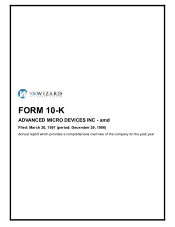AMD 1996 Annual Report Download - page 7
Download and view the complete annual report
Please find page 7 of the 1996 AMD annual report below. You can navigate through the pages in the report by either clicking on the pages listed below, or by using the keyword search tool below to find specific information within the annual report. PART I
ITEM 1. BUSINESS
CAUTIONARY STATEMENT REGARDING FORWARD-LOOKING STATEMENTS
THE STATEMENTS IN THIS REPORT THAT ARE FORWARD-LOOKING ARE BASED ON CURRENT
EXPECTATIONS AND BELIEFS AND INVOLVE NUMEROUS RISKS AND UNCERTAINTIES THAT
COULD CAUSE ACTUAL RESULTS TO DIFFER MATERIALLY. THE FORWARD-LOOKING
STATEMENTS RELATE TO OPERATING RESULTS, CASH FLOWS, REALIZATION OF NET
DEFERRED TAX ASSETS, CAPITAL EXPENDITURES AND ADEQUACY OF RESOURCES TO FUND
OPERATIONS AND CAPITAL INVESTMENTS; FUTURE BUSINESS PROSPECTS FOR
MICROPROCESSORS, FLASH MEMORY DEVICE PRODUCTS AND OTHER PRODUCT LINES; THE
EFFECT OF FOREIGN EXCHANGE CONTRACTS AND INTEREST RATE SWAPS; THE DEVELOPMENT,
VALIDATION, CERTIFICATION, INTRODUCTION, MARKET ACCEPTANCE AND PRICING OF THE
K86 PRODUCTS; THE COMPANY'S COMMITMENT TO RESEARCH AND DEVELOPMENT; THE
EFFECTIVE UTILIZATION OF FAB 25 (AS DEFINED BELOW); AND PROJECTS WHICH ARE
PROPOSED OR UNDER CONSTRUCTION IN JAPAN, GERMANY AND CHINA. FOR A DISCUSSION
OF THE FACTORS THAT COULD CAUSE ACTUAL RESULTS TO DIFFER MATERIALLY, SEE SUCH
OTHER RISKS AND UNCERTAINTIES AS SET FORTH BELOW IN THIS REPORT OR DETAILED IN
THE COMPANY'S OTHER SECURITIES AND EXCHANGE COMMISSION REPORTS AND FILINGS.
GENERAL
Advanced Micro Devices, Inc. was incorporated under the laws of the state of
Delaware on May 1, 1969. The Company's mailing address and executive offices
are located at One AMD Place, Sunnyvale, California 94086, and its telephone
number is (408) 732-2400. Unless otherwise indicated, the terms "Company,"
"AMD" and "Registrant" in this report refer to Advanced Micro Devices, Inc.
and its subsidiaries.
AMD is a semiconductor manufacturer with manufacturing facilities in the
U.S. and Asia and sales offices throughout the world. The Company's products
include a wide variety of industry-standard integrated circuits (ICs) which
are used in many diverse product applications such as telecommunications
equipment, data and network communications equipment, consumer electronics,
personal computers (PCs) and workstations.
For a discussion of the risk factors related to the Company's business
operations please see the "Cautionary Statement Regarding Forward-Looking
Statements" and "Risk Factors" sections of Management's Discussion and
Analysis of Results of Operations and Financial Condition contained in the
1996 Annual Report to Stockholders.
INDUSTRY
The IC market has grown dramatically over the past ten years, driven
primarily by the demand for electronic business and consumer products. Today,
ICs are used in virtually all products involving electronics, including
personal computers and related peripherals, voice and data communications and
networking products, fax and copy machines, home entertainment equipment,
industrial control equipment and automobiles.
The market for ICs can be divided into separate markets for digital and
analog devices. AMD participates primarily in the market for digital ICs. The
three principal types of digital ICs used in most electronic systems are: (i)
memory circuits, (ii) logic circuits and (iii) microprocessors. Memory is used
to store data and programming instructions, logic is employed to manage the
interchange and manipulation of digital signals within a system, and
microprocessors are used for control and computing tasks. Set forth below is a
discussion of the principal segments of the digital IC market in which the
Company participates.
THE MEMORY MARKET
Memory ICs store data or programs and are characterized as either volatile
or non-volatile. Volatile devices lose their stored information after
electrical power is shut off, while non-volatile devices retain their stored
information. The three most significant categories of semiconductor memory are
(i) Dynamic Random Access Memory (DRAM) and (ii) Static Random Access Memory
(SRAM), both of which are volatile memories, and (iii) non-volatile memory,
which includes Read-Only Memory (ROM), Flash memory and Erasable Programmable
Read-Only Memory (EPROM) devices. DRAM provides large capacity "main" memory,
and
3
Source: ADVANCED MICRO DEVIC, 10-K, March 20, 1997




















